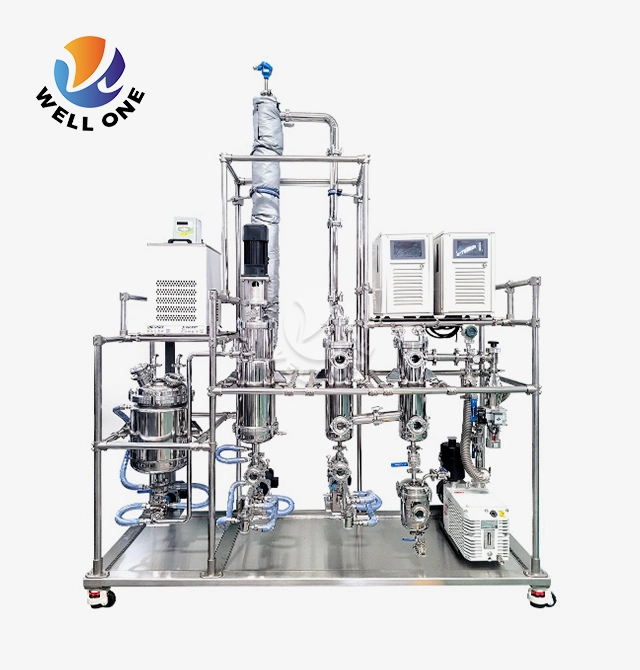Reduce Residence Time by 50%: The Thin Film Rectification Evaporator Advantage
In today's demanding industrial landscape, manufacturers face the critical challenge of processing heat-sensitive materials while maintaining product quality and maximizing efficiency. Traditional evaporation methods often fall short when dealing with thermolabile compounds, high-viscosity materials, and time-sensitive processes that require precise temperature control. The revolutionary Thin Film Rectification Evaporator emerges as the definitive solution, delivering unprecedented performance by reducing residence time by up to 50% compared to conventional evaporation systems. This breakthrough technology transforms how industries approach separation processes, offering superior heat transfer efficiency, minimal thermal degradation, and optimal product preservation across pharmaceutical, food, petrochemical, and specialty chemical applications.
Understanding Thin Film Rectification Evaporator Technology
The Thin Film Rectification Evaporator represents a paradigm shift in separation technology, fundamentally reimagining how materials undergo evaporation and distillation processes. Unlike traditional evaporators that rely on bulk liquid processing with extended residence times, the Thin Film Rectification Evaporator creates an ultra-thin liquid film on a heated surface, enabling rapid heat transfer and instantaneous vapor generation. This innovative approach dramatically reduces the time materials spend in contact with heated surfaces, minimizing thermal exposure and preserving the integrity of sensitive compounds. The technology operates on the principle of mechanical film generation, where rotating wipers or rollers spread the feed material into an extremely thin layer across the heated cylinder wall. This thin film configuration maximizes the surface area-to-volume ratio, creating optimal conditions for efficient mass and heat transfer. The Thin Film Rectification Evaporator achieves residence times measured in seconds rather than minutes, making it ideal for processing thermally sensitive materials that would otherwise degrade under prolonged heat exposure.
Advanced Heat Transfer Mechanisms
The superior performance of the Thin Film Rectification Evaporator stems from its advanced heat transfer mechanisms that optimize energy efficiency while maintaining gentle processing conditions. The thin film formation ensures direct contact between the heated surface and the material, eliminating the thermal resistance typically encountered in bulk liquid systems. This direct contact facilitates rapid heat transfer with minimal temperature gradients, enabling effective evaporation at significantly lower operating temperatures. The mechanical wiping action continuously renews the heated surface, preventing fouling and maintaining consistent heat transfer coefficients throughout the operation. This self-cleaning mechanism is particularly valuable when processing materials prone to scaling, crystallization, or polymerization, ensuring uninterrupted operation and consistent product quality. The Thin Film Rectification Evaporator's ability to handle viscous materials and maintain efficient heat transfer under challenging conditions sets it apart from conventional evaporation technologies.
Technical Advantages of Reduced Residence Time
The 50% reduction in residence time achieved by the Thin Film Rectification Evaporator delivers substantial technical advantages that directly impact product quality, operational efficiency, and process economics. Reduced residence time minimizes thermal degradation, preserves sensitive molecular structures, and maintains the bioactivity of pharmaceutical compounds. This benefit is particularly crucial in the production of high-value chemicals, natural extracts, and biological products where molecular integrity directly correlates with product efficacy and commercial value. The abbreviated residence time also reduces the risk of unwanted side reactions, polymerization, and thermal decomposition that commonly occur in conventional evaporation systems. This advantage enables manufacturers to achieve higher product yields, reduced waste generation, and improved process reliability. The Thin Film Rectification Evaporator's ability to operate at lower temperatures while maintaining high evaporation rates further enhances these benefits, creating a synergistic effect that optimizes overall process performance.
Enhanced Product Quality and Purity
The reduced residence time characteristic of the Thin Film Rectification Evaporator directly translates to enhanced product quality and purity across diverse industrial applications. In pharmaceutical manufacturing, the abbreviated thermal exposure preserves the potency of active pharmaceutical ingredients while minimizing the formation of degradation products and impurities. This quality preservation is essential for meeting stringent regulatory requirements and ensuring therapeutic efficacy in finished pharmaceutical products. For food industry applications, the reduced residence time maintains the nutritional value, flavor profiles, and functional properties of sensitive compounds such as vitamins, essential fatty acids, and bioactive molecules. The Thin Film Rectification Evaporator enables the production of high-quality MCT oils, specialty fats, and nutritional supplements with superior organoleptic properties and extended shelf life. The gentle processing conditions preserve heat-labile nutrients that would otherwise be lost in conventional processing methods.
Industrial Applications and Performance Benefits
The versatility of the Thin Film Rectification Evaporator extends across multiple industries, each benefiting from the technology's unique combination of reduced residence time, gentle processing, and high separation efficiency. In the pharmaceutical sector, the technology excels in the purification of pharmaceutical intermediates, the concentration of fermentation broths, and the recovery of valuable compounds from plant extracts. The ability to operate under high vacuum conditions enables the processing of high-boiling compounds at moderate temperatures, preserving their chemical integrity and biological activity. The food and nutraceutical industries leverage the Thin Film Rectification Evaporator for the concentration and purification of omega-3 fatty acids, the production of high-purity MCT oils, and the extraction of valuable compounds from natural sources. The technology's ability to handle viscous materials and maintain product quality makes it ideal for processing specialty oils, carotenoids, and other high-value food ingredients. The reduced residence time ensures minimal thermal impact, preserving the nutritional and functional properties that define premium food products.
Petrochemical and Specialty Chemical Processing
In petrochemical applications, the Thin Film Rectification Evaporator demonstrates exceptional performance in the purification of synthetic lubricants, the recovery of plasticizers, and the processing of high-temperature heat transfer fluids. The technology's ability to operate under extreme conditions while maintaining gentle treatment makes it suitable for processing sensitive petrochemical products that require precise separation without thermal degradation. The reduced residence time minimizes cracking reactions and preserves the desired molecular structures in complex hydrocarbon mixtures. The specialty chemical industry benefits from the Thin Film Rectification Evaporator's capability to process reactive materials, handle fouling applications, and maintain product consistency under challenging conditions. Applications include the purification of epoxy resins, the concentration of OLED materials, and the processing of advanced polymer additives. The technology's self-cleaning action and reduced residence time enable continuous operation with materials that would otherwise cause significant fouling in conventional equipment.
Well One's Technical Specifications and Quality Standards
Xi'an Well One Chemical Technology Co., Ltd has engineered their Thin Film Rectification Evaporator with industry-leading specifications that deliver superior performance and reliability. The system achieves an exceptional vacuum degree of 0.1Pa, enabling operation at remarkably low temperatures while maintaining high evaporation rates. This ultra-high vacuum capability is essential for processing the most sensitive materials and achieving the 50% reduction in residence time that defines the technology's competitive advantage. The equipment incorporates premium-grade 316 stainless steel construction, ensuring compatibility with aggressive chemicals and maintaining product purity throughout the processing cycle. The ABB control system provides precise process monitoring and automated operation, enabling consistent performance and optimal process control. These technical specifications reflect Well One's commitment to delivering equipment that meets the most demanding industrial requirements while providing long-term reliability and operational efficiency.
Quality Assurance and Certification Standards
Well One's Thin Film Rectification Evaporator systems meet comprehensive international quality standards, including CE, ISO, UL, and SGS certifications. These certifications validate the equipment's safety, performance, and reliability across global markets, providing customers with confidence in their investment and ensuring compliance with local regulations. The rigorous quality assurance processes implemented throughout manufacturing guarantee consistent product quality and operational reliability. The company offers flexible configuration options including single-stage, dual-stage, and three-stage systems to accommodate diverse processing requirements. This scalability enables customers to select the optimal configuration for their specific applications while maintaining the core benefits of reduced residence time and gentle processing. The OEM and ODM support capabilities allow for customized solutions that address unique process challenges and integration requirements.
Process Optimization and Operational Efficiency
The Thin Film Rectification Evaporator's design philosophy centers on process optimization and operational efficiency, delivering measurable improvements in productivity and cost-effectiveness. The reduced residence time directly correlates with increased throughput capacity, enabling higher production rates without compromising product quality. This efficiency gain translates to improved asset utilization and enhanced return on investment for manufacturing operations. The technology's ability to operate at lower temperatures reduces energy consumption compared to conventional evaporation systems, delivering significant operational cost savings. The combination of reduced residence time and lower operating temperatures creates a multiplicative effect on energy efficiency, making the Thin Film Rectification Evaporator an environmentally sustainable choice for industrial separation processes. The self-cleaning action minimizes downtime for maintenance and cleaning, further enhancing operational efficiency and production continuity.
Maintenance and Reliability Considerations
The robust design of the Thin Film Rectification Evaporator incorporates high-quality components that ensure reliable operation and minimal maintenance requirements. The KingLai brand vacuum ball valves enhance system vacuum performance while providing long-term reliability and easy maintenance access. The SEW brand motors meet UL listing requirements and deliver consistent power with extended service life, reducing maintenance frequency and operational disruption. The PTFE and graphite wiper components offer exceptional chemical resistance and durability, maintaining consistent performance even under challenging processing conditions. These materials minimize wear and friction, extending component life and reducing replacement frequency. The comprehensive one-year warranty demonstrates Well One's confidence in their equipment quality and provides customers with additional assurance of their investment protection.
Economic Impact and Return on Investment
The economic advantages of implementing Thin Film Rectification Evaporator technology extend far beyond the initial capital investment, delivering substantial returns through improved product quality, increased throughput, and reduced operating costs. The 50% reduction in residence time enables higher processing rates and improved asset utilization, directly impacting production capacity and revenue generation. This throughput improvement is particularly valuable in high-margin applications where production bottlenecks limit profitability. The technology's ability to minimize product degradation and maximize yield translates to reduced raw material costs and waste generation. In pharmaceutical and specialty chemical applications, even small improvements in yield can result in significant cost savings due to the high value of starting materials and finished products. The Thin Film Rectification Evaporator's gentle processing capabilities enable the recovery of valuable compounds that would otherwise be lost in conventional processing methods.
Long-term Operational Benefits
The long-term operational benefits of the Thin Film Rectification Evaporator include reduced maintenance costs, extended equipment life, and improved process reliability. The self-cleaning action minimizes fouling and scaling, reducing the frequency of cleaning cycles and maintenance interventions. This reliability improvement reduces unplanned downtime and maintains consistent production schedules, supporting customer satisfaction and market competitiveness. The energy efficiency gains achieved through reduced operating temperatures and shorter residence times contribute to lower utility costs and reduced environmental impact. These operational savings accumulate over the equipment's service life, providing ongoing economic benefits that enhance the total cost of ownership profile. The combination of improved product quality, increased throughput, and reduced operating costs creates a compelling economic justification for Thin Film Rectification Evaporator technology adoption.
Future Developments and Technology Evolution
The continuous evolution of Thin Film Rectification Evaporator technology promises even greater performance improvements and expanded application possibilities. Ongoing research and development efforts focus on further reducing residence times, improving energy efficiency, and expanding the range of materials that can be processed effectively. These developments will enable new applications and provide existing users with upgrade paths that enhance their competitive position. The integration of advanced process control systems and Industry 4.0 technologies will enable real-time optimization and predictive maintenance capabilities. These enhancements will further improve operational efficiency while reducing the risk of equipment failures and production disruptions. The Thin Film Rectification Evaporator's fundamental advantages in reduced residence time and gentle processing position it as a key technology for future industrial separation challenges.
Conclusion
The Thin Film Rectification Evaporator represents a transformative advancement in separation technology, delivering the critical advantage of 50% reduced residence time while maintaining superior product quality and operational efficiency. This breakthrough performance enables manufacturers across pharmaceutical, food, petrochemical, and specialty chemical industries to process sensitive materials with unprecedented precision and reliability. The technology's combination of gentle treatment, high efficiency, and robust design makes it an essential solution for modern industrial processing challenges.
Cooperate with Xi'an Well One Chemical Technology Co., Ltd
As a leading China Thin Film Rectification Evaporator manufacturer and China Thin Film Rectification Evaporator supplier with 17 years of expertise, Xi'an Well One Chemical Technology Co., Ltd stands ready to deliver cutting-edge solutions for your separation challenges. Our comprehensive services include feasibility research, process development, and pilot testing, ensuring optimal equipment selection and configuration for your specific applications. As your trusted China Thin Film Rectification Evaporator factory, we offer OEM & ODM support with advanced 3D design capabilities and High Quality Thin Film Rectification Evaporator systems. Whether you need China Thin Film Rectification Evaporator wholesale solutions or individual Thin Film Rectification Evaporator for sale, our competitive Thin Film Rectification Evaporator price and superior quality guarantee exceptional value. Contact us at info@welloneupe.com to discuss your requirements and discover how our proven technology can optimize your processes while delivering the 50% residence time reduction advantage your operations demand.
FAQ
Q: How does the Thin Film Rectification Evaporator achieve 50% reduction in residence time?
A: The technology creates ultra-thin liquid films on heated surfaces with mechanical wipers, enabling rapid heat transfer and instant vaporization compared to bulk liquid processing methods.
Q: What materials can benefit from reduced residence time processing?
A: Heat-sensitive pharmaceuticals, natural extracts, high-viscosity materials, and compounds prone to thermal degradation or polymerization benefit most from reduced residence time processing.
Q: What are the typical operating temperatures for Thin Film Rectification Evaporators?
A: Operating temperatures typically range from 85-87°C under vacuum conditions, significantly lower than conventional evaporation methods while maintaining high separation efficiency.
Q: How does reduced residence time impact product quality and yield?
A: Reduced residence time minimizes thermal degradation, preserves molecular integrity, reduces unwanted reactions, and increases product yields by protecting valuable compounds from heat damage.
References
1. "Experimental Investigation of Residence Time Distribution in Wiped Film Evaporators" - Journal of Chemical Engineering and Processing, Authors: Chen, L., Wang, M., Zhang, H.
2. "Thermal Processing of Heat-Sensitive Materials Using Short Residence Time Technologies" - Industrial & Engineering Chemistry Research, Authors: Martinez, R., Thompson, K., Liu, S.
3. "Advanced Separation Technologies for Pharmaceutical Manufacturing" - Chemical Engineering Progress, Authors: Anderson, P., Roberts, J., Kim, D.
4. "Process Intensification Through Thin Film Evaporation: Fundamentals and Applications" - Chemical Engineering Science, Authors: Brown, A., Wilson, T., Garcia, M.







